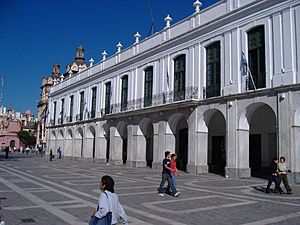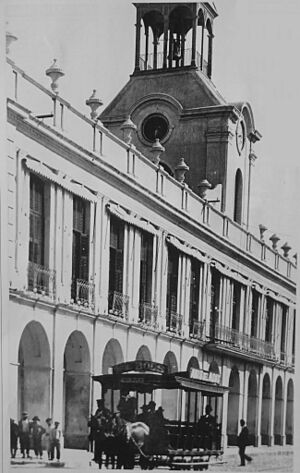Córdoba Cabildo facts for kids
The Córdoba Cabildo was the main government building, like a town hall, in Córdoba, Argentina during the time it was a Spanish colony. It was where important decisions for the city were made.
History of the Cabildo
In the early days, after Córdoba was founded in 1573, the local government leaders met in their own homes. The very first building made for this purpose started in 1588. It was a simple structure made of adobe (a type of mud brick) with a thatched roof. This was common for buildings in Spanish colonies back then.
In 1610, a stronger wooden building designed by Alonso de Encinas replaced the first one. This new Cabildo had an office for the Alcalde (who was like the mayor), living areas, and a small jail.
Building a Bigger Cabildo
In 1749, the Alcalde, José Moyano Oscariz, ordered a much larger building to be built. The Governor of Córdoba, Rafael Núñez (also known as the Marquess of Sobremonte), arrived in 1783. He made sure the new Cabildo project, which had been delayed, was finally completed.
He hired Juan Manuel López for the new design. This new building would have much more office space. It would also feature grand steps, a chapel, a patio, and a long archway with fifteen columns at the front. There was also a covered walkway along the archway where shops could be set up.
The construction happened very quickly and was finished in 1786. At this time, the Santa Catalina Promenade was also opened. This walkway connected the Cabildo to the Córdoba Cathedral, which had been built recently.
Changes Over Time
In 1885, the Cabildo got Marble on its outside walls and a bell tower. However, the bell tower was removed in the late 1930s. This was part of a project to restore many historic buildings in Argentina. The goal was to make them look more like their original designs.
The Córdoba Cabildo, along with the Cathedral, was declared a National Historic Monument in 1941. This means it is a very important historical site.
The city government moved out of the Cabildo in the late 1800s. They moved to a new building that looked like old European Renaissance Revival architecture. Later, in the 1960s, they moved again to a more modern building, which is where they are today.
In 1980, the City Historical Museum opened inside the Cabildo. Today, visitors can explore the museum and learn about Córdoba's past.
See also
 In Spanish: Cabildo de Córdoba para niños
In Spanish: Cabildo de Córdoba para niños



